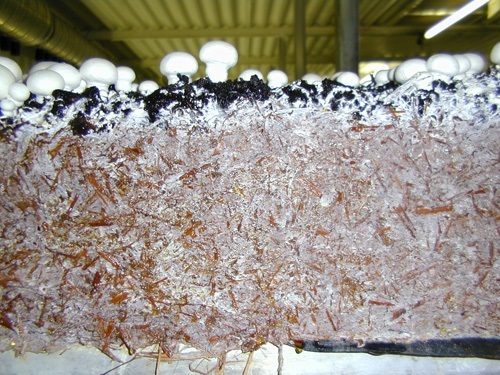
“Our hypothesis was that metabolic strategies and niche adaptations of Agaricus might not be present in the white-rot and brown-rot wood-decomposing fungi,” said senior author Francis Martin, Head of the ARBRE Lab of Excellence at INRA, Nancy, France.
“Compared to genomes of these fungi, that we previously characterized, the Agaricus genome surprisingly has shown many similarities in gene composition,” added Igor Grigoriev, the study’s senior co-author and leader of the DOE JGI Fungal Program, “At the same time, our data also supported the view that Agaricus fits neither brown-rot nor white-rot classifications and that its adaptation to growing in a leaf-litter humic-rich environment is not typical of classic wood degrading fungi.”
The ancient Romans used the word “humus” to designate soil and compost, the complex natural interaction of organic compounds from plant cell wall residues. Humus contributes the chemicals that drive the decomposition process through substances like humic acid that serve as a complement to fertilizer, adding organic matter to deficient soils and contributing to overall plant health to foster root vitality and stimulate the growth of beneficial microbial communities in the soil.
Agaricus is the ideal mushroom to study for adaptation and growth in humic-rich environments, noted Grigoriev and his co-authors. They surveyed the genomes and the transcriptomes—the subset of genes expressed under particular conditions— of two A. bisporus lines, a commercial strain and related wild variety. This analysis of Agaricus turned up several families of well-known sugar-degrading enzymes similar to the repertoire found in wood-decaying fungi. However, the enzymes in Agaricus such as heme-thiolate peroxidases and etherases predominate in the presence of humus-rich soil habitats, suggesting a higher ability to metabolize complex mixtures of derivatives of lignin and other polymers.
“The ability to use proteins prevalent in soil confers an advantage to Agaricus over other fungal scavengers,” said Martin. “To our knowledge, Agaricus had not been shown in nature to decompose wood,” said Martin. “Yet, we now see how Agaricus has adapted to growing in this ecological niche. Our understanding of the carbon cycling role of Agaricus in ecosystems is a prerequisite to modeling and optimizing carbon management for sustainable forests.”
Unlike brown-rot and white-rot fungi, A. bisporus is a very poor competitor on fresh non-degraded plant wastes like wood but competes well on partially decomposed litter on forest floors and grassland soils rich in humic substrates. The comparative analysis also revealed a dozen other genes that are dialed up during mushroom formation. “Key master switches may be manipulated to control fruiting body formation—the mechanisms triggering the complex cascade that leads from undifferentiated mycelia, the mass of branching, thread-like fingers, to the button mushrooms most commonly consumed” said Martin.
“Comparative genomics of fungi just got more interesting because the contributions of Emmanuelle Morin at INRA and the 42 co-authors, many of them at the JGI, that led to analysis of the Agaricus genome,” said John Taylor, Professor of Plant and Microbial Biology at the University of California, Berkeley and member of the DOE JGI Fungal Advisory Committee. “The most exciting discovery may be the expansion of these heme-thiolate peroxidases, the versatile catalysts that have an important industrial applications and seemingly allow Agaricus to live in humus, the lignin-rich residue of plants that pervade compost.” Such industrial applications include the breakdown of lignin-derived compounds in novel biorefineries to obtain novel high value chemicals.
Taylor further considered the implications of the findings as applied to climate trends. “If the peroxidases do degrade humus, there could be serious effects on the sequestration of soil carbon as soil warms.”
Martin pointed out that additional value will be accrued by making the gene map of Agaricus publically available: for identifying pathogen resistance traits and for highlighting wild germplasm collections benefiting the multi-billion dollar industry producing the button mushroom. “The genome sequence will expedite mushroom breeding for improved agronomic characteristics,” he said.
The DOE JGI is among leading worldwide contributors of fungal genomes to the public databases, having sequenced over 150 fungal genomes, providing a vital computational infrastructure for such large-scale comparative analyses. The Agaricus genome, originally proposed by Mike Challen, while at the University of Warwick, now at the Wellcome Trust Centre for Human Genetics, University of Oxford, UK., was sequenced under the auspices of the DOE JGI’s Community Sequencing Program, supported by DOE’s Office of Science. The CSP was launched in 2004 to provide the scientific community at large with access to unparalleled capabilities in massive-throughput sequencing, computational analysis and other genomic resources for projects of relevance to DOE missions in alternative energy production, global carbon cycling, and biogeochemistry. Sequencing projects are chosen based on scientific merit—judged through independent peer review.
























